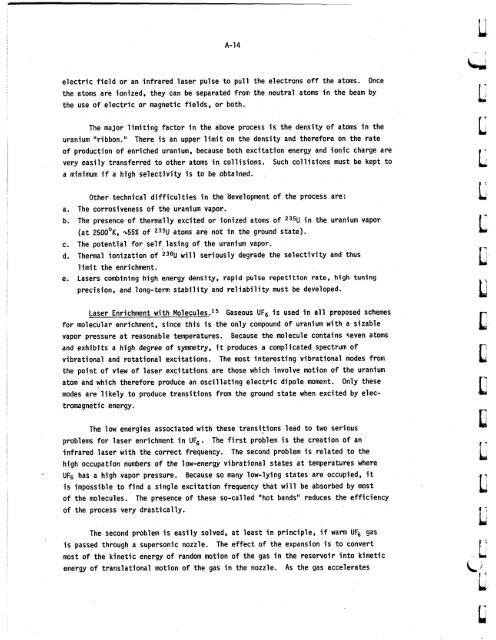ORNL-5388 - the Molten Salt Energy Technologies Web Site
ORNL-5388 - the Molten Salt Energy Technologies Web Site
ORNL-5388 - the Molten Salt Energy Technologies Web Site
You also want an ePaper? Increase the reach of your titles
YUMPU automatically turns print PDFs into web optimized ePapers that Google loves.
'<br />
A-14<br />
electric field or an infrared laser pulse to pull <strong>the</strong> electrons off <strong>the</strong> atoms. Once<br />
<strong>the</strong> atoms are ionized, <strong>the</strong>y can be separated from <strong>the</strong> neutral atoms in <strong>the</strong> beam by<br />
<strong>the</strong> use of electric or magnetic fields, or both.<br />
The major limiting factor in <strong>the</strong> above process is <strong>the</strong> density of atoms in <strong>the</strong><br />
uranium "ribbon." There is an upper limit on <strong>the</strong> density and <strong>the</strong>refore on <strong>the</strong> rate<br />
of production of enriched uranium, because both excitation energy and ionic charge are<br />
very easily transferred to o<strong>the</strong>r atoms in collisions. Such collisions must be kept to<br />
a minimum if a high selectivity is to be obtained.<br />
O<strong>the</strong>r technical difficulties in <strong>the</strong> 'development of <strong>the</strong> process are:<br />
a. The corrosiveness of <strong>the</strong> uranium vapor.<br />
b. The presence of <strong>the</strong>rmally excited or ionized atoms of 235U in <strong>the</strong> uranium vapor<br />
(at 2500°K, 45% of 23% atoms are not in <strong>the</strong> ground state).<br />
c. The potential for self lasing of <strong>the</strong> uranium vapor.<br />
d. Thermal ionization of 238U will seriously degrade <strong>the</strong> selectivity and thus<br />
e.<br />
limit <strong>the</strong> enrichment.<br />
Lasers combining high energy density, rapid pulse repetition rate, high tuning<br />
precision, and long-term stability and reliability must be developed.<br />
Laser Enrichment with molecule^.^^ Gaseous UF6 is used in all proposed schemes<br />
for molecular enrichment, since this is <strong>the</strong> only compound of uranium with a sizable<br />
vapor pressure at reasonable temperatures. Because <strong>the</strong> molecule contains zeven atoms<br />
and exhibits a high degree of symmetry, it produces a complicated spectrum of<br />
vibrational and rotational excitations. The most interesting vibrational modes from<br />
<strong>the</strong> point of view of laser excitations are those which involve motion of <strong>the</strong> uranium<br />
atom and which <strong>the</strong>refore produce an oscillating electric dipole moment. Only <strong>the</strong>se<br />
modes are'likely to produce transitions from <strong>the</strong> ground state when excited by electromagnet<br />
ic energy.<br />
The low energies associated with <strong>the</strong>se transiFions lead to two serious<br />
problems for laser enrichment in UF6. The first problem is <strong>the</strong> creation of an<br />
infrared laser with <strong>the</strong> correct frequency. The second problem is related to <strong>the</strong><br />
high occupation numbers of <strong>the</strong> low-energy vibrational states at temperatures where<br />
UF6 has a high vapor pressure. Because so many low-lying states are occupied, it<br />
is impossible to find a single excitation frequency that will be absorbed by most<br />
of <strong>the</strong> molecules. The presence of <strong>the</strong>se so-called "hot bands" reduces <strong>the</strong> efficiency<br />
of <strong>the</strong> process very drastically.<br />
The second problem is easily solved, at least in principle, if warm UF6 gas<br />
is passed through a supersonic nozzle. The effect of <strong>the</strong> expansion is to convert<br />
most of <strong>the</strong> kinetic energy of random motion of <strong>the</strong> gas in <strong>the</strong> reservoir into kinetic<br />
energy of translational motion of <strong>the</strong> gas in <strong>the</strong> nozzle. As <strong>the</strong> gas accelerates<br />
L<br />
1:<br />
L<br />
L<br />
P<br />
c<br />
L<br />
P<br />
L<br />
I'<br />
c



![Review of Molten Salt Reactor Physics Calculations [Disc 2]](https://img.yumpu.com/21979492/1/190x247/review-of-molten-salt-reactor-physics-calculations-disc-2.jpg?quality=85)












